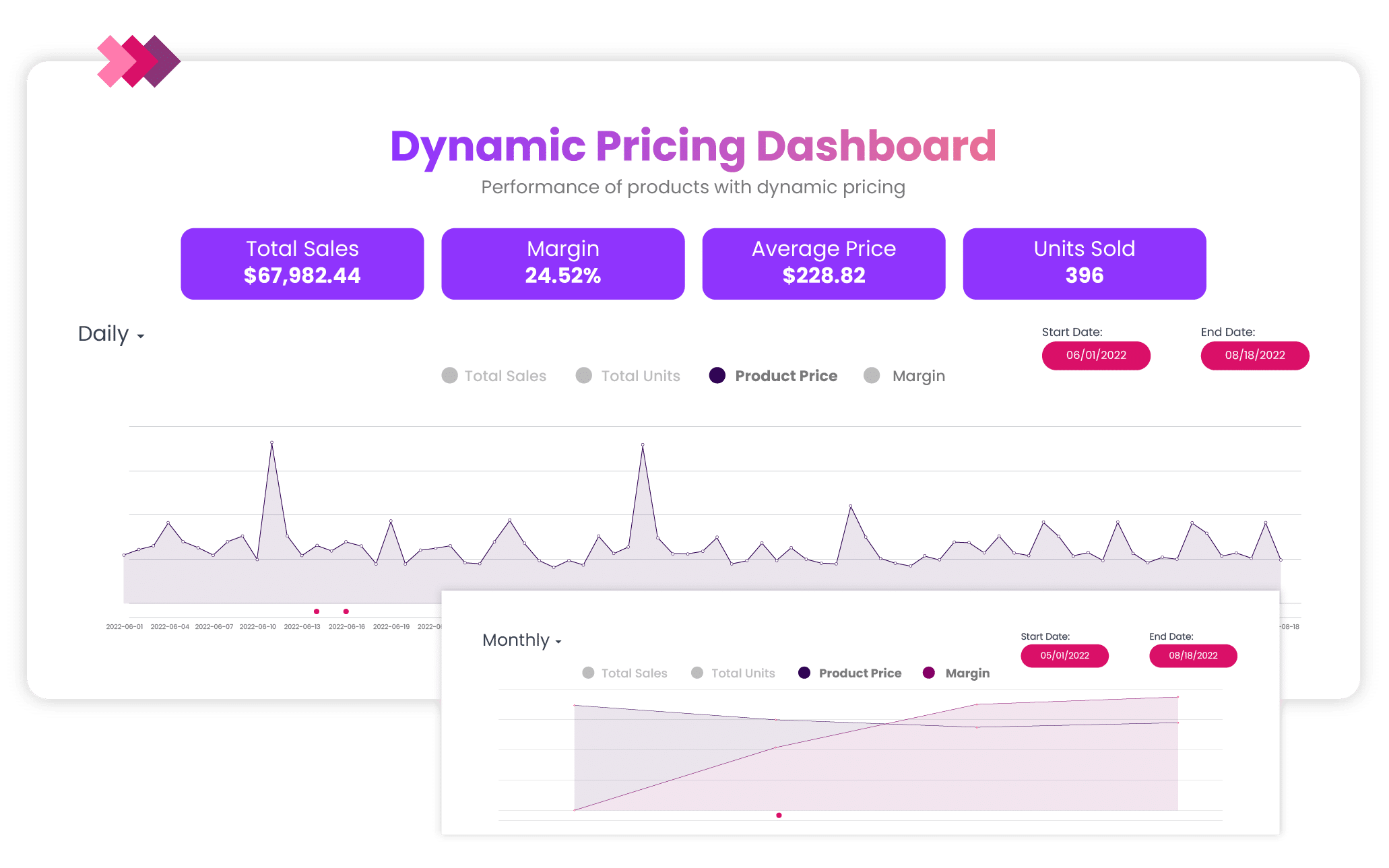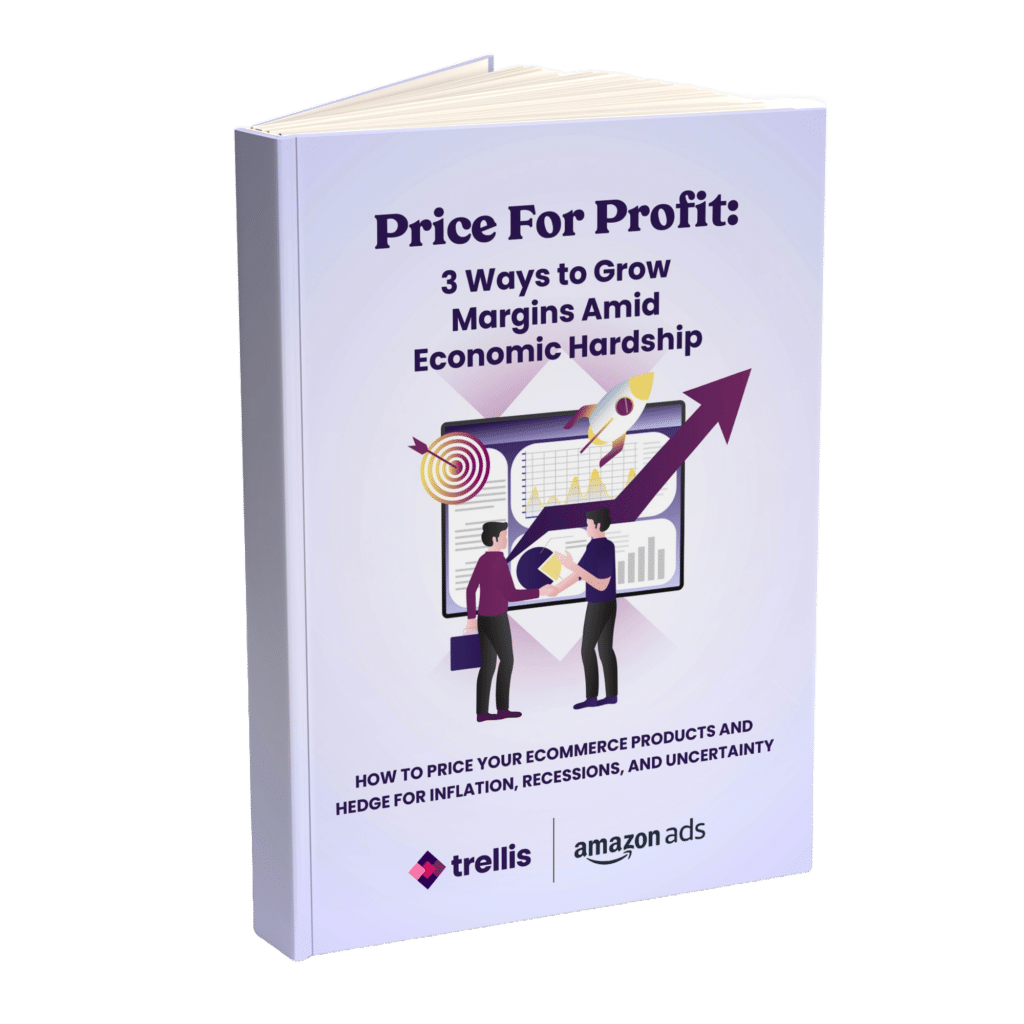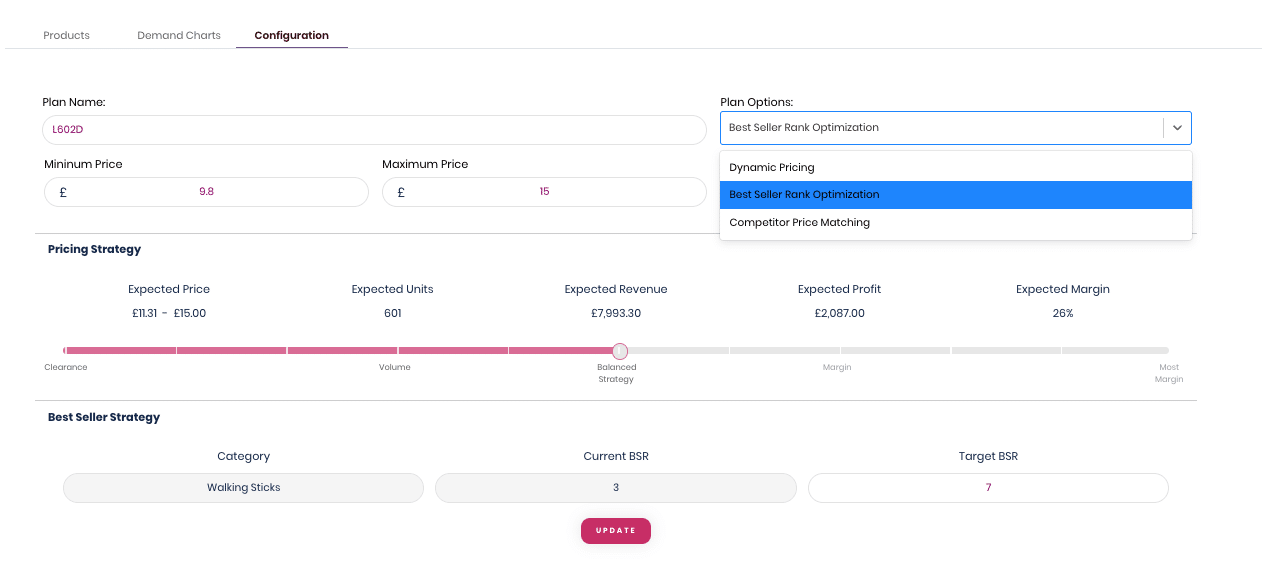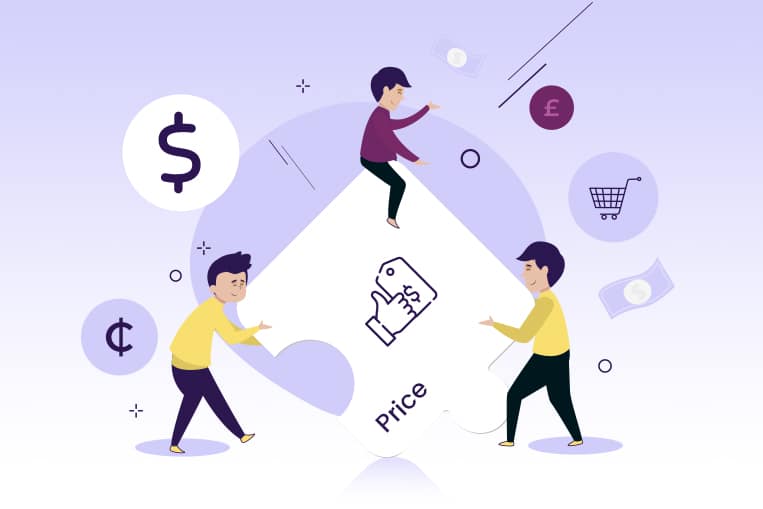You can no longer win on Amazon solely by being in the right place at the right time. You need to compete on pricing and value.
Your close proximity to competitors on Amazon means buyers can easily find value for their money, forcing sellers to become hyper-competitive in how they list their products. You likely are already optimizing your product images, title, content, and reviews, but how much have you tested the price of your products? Likely not enough considering that 80% of online shoppers compare prices before purchasing a product.
Driven by this problem, we did what any merchandising automation company would do and built a solution that gives users daily control of their optimal price. We explored a way to seamlessly gather and structure pricing data to automate a product’s cost based on your business objectives.
What is Dynamic Pricing?

Dynamic Pricing is a pricing strategy in which the price of a product or service is adjusted in real-time based on various factors such as demand, competition, market conditions, and customer behavior. Instead of a fixed price, Dynamic Pricing allows prices to adapt to maximize revenue, profit, or other business objectives.
Dynamic Pricing is commonly used in industries such as travel and hospitality (airlines, hotels), ride-sharing services (Uber, Lyft), entertainment (ticket sales), and recently in e-commerce (Amazon). It enables businesses to respond quickly to changing market conditions, optimize revenue, and maximize profits. This is done by adjusting prices to match a customer’s willingness to pay, capturing additional value during peak demand periods, and avoiding huge losses in the off-periods.

Increase Your RoAS By 38%
These 3 Amazon pricing strategies will have your competitors scrambling to keep up.
Why Dynamic Pricing is the Most Effective Pricing Strategy
Dynamic Pricing finds the optimal price point by balancing supply and demand. This ensures sellers can sell their products or services at the highest possible price without losing customers due to excessive pricing.
Dynamic pricing takes into account factors like inventory levels, competitor prices, historical sales data, seasonality, time of day, location, customer demographics, and even external factors like weather or events.
Looking at all the other tool-based pricing strategies, Dynamic Pricing outperforms them all with its flexibility, complexity, and efficiency. Here are some common tool-based pricing strategies that work for specific use-cases.
- Surge pricing: Increasing prices when demand is higher than supply
- Time-based pricing: Adjusting prices based on time of day, day of the week, or season.
- Personalized pricing: Tailoring prices to customers’ purchase history and preferences
- Competitive pricing: Adjusting prices based on competitors’ price changes
Dynamic Pricing integrates all of the above tool-based pricing strategies and creates a much more advanced algorithm that takes more input and provides better output.
Importance of Dynamic Pricing for Amazon & eCommerce
When we talk about pricing tools for Amazon, it shouldn’t start and end at the Buy Box. Dynamic Pricing provides much more than just repricing your products and pricing-out the competition. It is also about being profitable and finding the right balance between sales and profit.
An eCommerce business usually has a range of products that require tools to manage the pricing of several products. An automated pricing tool that adjusts prices based on your goals will save you time and money, and provide more efficient results.
Given the high level of competition and how easy it is to compare prices, eCommerce sellers should be prepared for price-sensitive customers looking for the best deal.
Trellis’ Dynamic Pricing not only auto-adjusts prices but also provides price models for users so they can make better pricing decisions across all of their eCommerce channels. Through the right pricing tool, you can maximize profitability on your best-sellers, increase sales volume on your new products, and price competitively on your introductory products.
Easy to use and cost-effective, you no longer have to price your products using a cost-plus pricing strategy or by undercutting competitors. You don’t have to take your products to expensive focus groups or manually test them without a reliable framework. Now you can get a price driven by data updated every day.
How Does Dynamic Pricing Work on Amazon?
Dynamic Pricing structures your data through a series of tests. Once the data is modeled, we select the price points that suit your objectives and change the price of your products as needed.
1. Reverse-Engineer Your Objective
Dynamic Pricing uses your goal as a north star but uses your data to ensure that you aren’t pricing less or more than you have to to get there.
By listening to our customers over the last 2 years, we’ve established three goals you can optimize for:
Margin vs. Sales Optimization
You can either set your pricing to optimize for more sales, a higher profit margin or keep it balanced. This helps you achieve your immediate goals whether you want to lower your price and sell more or increase your price and maintain a higher margin.
Best Seller Rank Optimization
Many sellers aim for Best Seller Rank (BSR) by adjusting their prices. Targeting BSR can get you enough reviews and help build your product listing. Simply enter the Target BSR and let the algorithm increase your sales through price adjustment.
Challenge a Competitor
You can add a competitor and out-price them every time they change the price. If you have similar products to your competitors, this strategy could help you in getting more clicks and possible conversions.

Building Pricing Profiles
Starting out, you likely haven’t made enough pricing changes to your products for accurate projections. Unsurprisingly, we’ve created a method to automate this step. By taking a few data points from you, importing any historical data, and understanding your goal, we test prices to build a Pricing Profile.
This modeling helps us to find outliers and trends with statistical significance. The system then analyzes this data and connects your goals to these opportunities.

Dynamic Pricing
While Pricing Profiles are completely available to you, Dynamic Pricing leverages it daily without any human hand-holding. Once you set how fast you want your product to sell and at what profit, our system changes your prices daily.
This monitoring is increasingly important as over 2.5 million price changes happen a day. That means an advantageous price today doesn’t guarantee a prosperous price tomorrow. Dynamic Pricing keeps up with trends, seasonality, and competitors to ensure you are the best value for your customers’ money.
5 Common Uses of Dynamic Pricing
Looking for a specific solution for one of your products? We have 5 common use cases for Dynamic Pricing that might help.
1. Identify Goldilocks Pricing
As products become popular with customers, you will want to find the price that will move the most products for the most amount of money.
If you price too low you may move warehouses of products but your profit margins may be small. While pricing your products too high might mean great individual margins but small profits overall due to low sales volume.
This is where Goldilocks Pricing comes in. It is a “just right” price that doesn’t make the most overall sales or the highest margins per product but will make a huge splash on your bottom line when everything is said and done.
2. Market Penetration, Loss Leaders & Product Launches
Looking to make a splash in your category and have a strategy to convert first-time buyers to repeat customers? Increasing sales volume is likely a good place to start.
However, to make matters a bit more complicated, this price isn’t always the lowest price. Many will see the lowest price as a poor quality product, while in other circumstances you may have dropped your price much lower than you had to.
With Dynamic Pricing, you are able to find a price that will make some noise without harming your bottom line.
3. Competitor Bidding
By identifying your competitors, you can bid a percentage below or above them.
Competitor bidding is a strong use case if you have:
- An established product that you’re looking to protect
- A specific competitor that you want to force out of the market
- An industry you want to disrupt and need a low price to mitigate hesitancy
4. Stock Management
Amazon often penalizes products and accounts that are regularly out of stock. To them, it is an issue if their marketplace has sellers who can’t generate purchases and if you’re out of stock there’s nothing for Amazon customers to buy. This means your organic rank can drop and your listing may disappear altogether.
To avoid being one of these sellers, you can adjust your price to slow down sales.
By leveraging Dynamic Pricing projections, you can also see how many sales you should get over a certain period. Using this data you can set a price that will slow down sales until you expect a restock. In general, this functionality can help you plan your supply chain better.
5. Combine with Advertising
Upfront, advertising can help you gather data on optimal pricing, accelerating the advancement of your pricing profiles.
In the long term, advertising can be used to leverage your ideal price at scale. This means if you’re trying to speed up sales or scale your Goldilocks price, a strong advertising engine can help.
Inversely, Dynamic Pricing can make sure that your products cost what people want to pay. If your products are overpriced, Dynamic Pricing could lower it to find a price that improves your conversion rate exponentially more than your average order value decreases.
Alternatively, if your product’s price is too low, dynamic pricing will raise the price. This increase may lead to a small shift in sales volume but comes with a significant decrease in ACoS as you move larger orders.
What Now?
If you’ve been thinking about a re-pricer or Dynamic Pricing, this might be the time to pull the trigger.
Trellis offers a low barrier to entry to pricing your products simply and effectively.
Book a demo with a member of our team to learn more and get started today!



